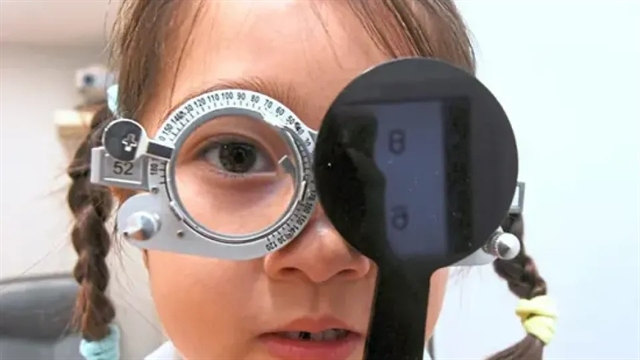 Society
Society
.jpg)
 |
| Cases of childhood myopia are spiralling up nationwide, experts said, but it can still be curbed if parents encourage outdoor play, limit screentime to 30 minutes a day, and ensure children undergo annual eye check-ups starting at age five. PHOTO: THE STAR |
PETALING JAYA – Experts warn that without intervention, childhood myopia may soon become the norm rather than the exception in Malaysian classrooms.
The condition is spiralling up nationwide, they said, but it can still be curbed if parents encourage outdoor play, limit screentime to 30 minutes a day and ensure children undergo annual eye check-ups starting at age five.
According to them, up to one in three Malaysian schoolchildren under 15 now suffer from myopia, or short-sightedness, with prevalence rising rapidly from 7% in Year One to 30% by the time they enter secondary school, driven largely by excessive screen use and limited time outdoors.
Prof Dr Mae-Lynn Catherine Bastion, a vitreoretinal diseases and surgery lecturer at Universiti Kebangsaan Malaysia, said recent screenings revealed an alarming snapshot of post-pandemic childhood vision in urban areas.
Under the Malaysian Advocacy for Myopia Prevention Board, her team screened 459 children aged six to 12 from four Klang Valley schools between 2022 and 2024.
“We found that 57.3% had refractive errors. Of these, 33.6% were myopic, 41% had astigmatism, 7.4% were hyperopic and 2% had high myopia.
“The highest prevalence of myopia was at age nine, at 44.7%,” she said when contacted yesterday.
She warned that elongation of the eyeball caused by myopia is irreversible and could increase the risk of complications such as early cataracts and retinal conditions in adulthood.
“Lazy eye, or amblyopia, is most responsive to treatment before age nine,” she added, stressing the need for early detection.
Dr Bastion advised limiting near work, like screen use, encouraging outdoor play and following medical advice when using corrective methods such as contact lenses.
“If both parents are short-sighted, the child’s risk is higher. Eye checks should begin in preschool, or at least by age seven,” she said.
She also urged the Health Ministry to collaborate closely with the Education Ministry, and called for Malaysia to follow countries like Hong Kong, Singapore and Taiwan where schools have made outdoor time mandatory.
“Don’t wait for the numbers to spike before acting,” she added.
Optometrist Mohd Abdul Latif Abdul Rahman said prolonged gadget use, reduced daylight exposure and rapid urbanisation have all contributed to the surge in myopia among the young.
He said many children go undiagnosed until their vision deteriorates significantly, often affecting their academic performance.
“Parents often overlook signs like squinting, headaches or their child moving closer to the television or board. By the time they notice, the condition has already progressed,” he said.
On whether girls are more susceptible to myopia, as highlighted in a 2023 study by the International Myopia Institute, Abdul Latif said hormonal and behavioural differences play a role.
“Oestrogen can cause eyeball elongation, and girls generally spend less time outdoors than boys,” he said.
He also encouraged routine vision screening from age five, even if symptoms are not obvious, as many children assume blurry vision is normal.
He added that natural sunlight has been shown to reduce the risk of developing myopia by up to 50%.
“Sunlight helps slow the elongation of the eyeball, which is the key factor in myopia progression.
“Also, children should not have more than 30 minutes of uninterrupted screentime. Breaks are crucial,” he said.
Clinical paediatric optometrist Rebecca Lee Sin Yen said early patterns of vision problems are already visible among younger children.
“Based on our screenings, about one-third of preschoolers aged five to six are unable to see clearly in class.
“By the end of primary school, nearly half of Malaysian children develop myopia,” she said.
She attributed the trend to urban lifestyles, lack of outdoor play and excessive screen exposure.
Without timely action, she said, many children risk developing high myopia, which significantly increases the chance of retinal disease later in life.
Lee urged parents, educators and communities to treat children’s vision as a shared responsibility.
“Regular eye checks, at least two hours of outdoor play and healthy screen habits like the 20-20-20 rule are essential,” she said, referring to the practice of looking at something 20 feet away for 20 seconds every 20 minutes of screen use.
She said schools can help by rotating seats, ensuring adequate lighting and integrating outdoor activities into the daily routine.
“For children at higher risk, early intervention – including special lenses, orthokeratology or medicated eye drops – can help slow progression.
“Early detection is key so that kids can see clearly now and protect their sight for life,” she added. THE STAR/ANN
.jpg)



